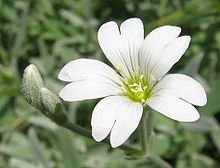Cerastium tomentosum
From Wikipedia, the free encyclopedia
| Cerastium tomentosum | |
|---|---|
 | |
| Scientific classification | |
| Kingdom: | Plantae |
| (unranked): | Angiosperms |
| (unranked): | Eudicots |
| (unranked): | Core eudicots |
| Order: | Caryophyllales |
| Family: | Caryophyllaceae |
| Genus: | Cerastium |
| Species: | C. tomentosum |
| Binomial name | |
| Cerastium tomentosum L. | |
Cerastium tomentosum (Snow-in-Summer) is a herbaceous flowering plant and a member of the carnation family. It is generally distinguished from other species of its genus by "tomentose" or felty foliage. It is a low, spreading perennial native to alpine regions of Europe. The stems & leaves are silvery-grey, whilst the flowers are star-like, white & about 15mm across. Not surprisingly, C. tomentosum flowers in summer, but may also bloom at other times of the year. It has proven popular as a cultivated ornamental and can be found in gardens the world over.











